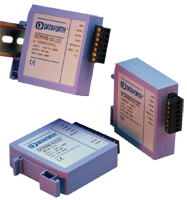SCM9B Series
Isolated, Intelligent Signal Conditioning Products
Certifications
Documents
Product Availability
Dimensions & Accessories
SCM9B MODULES
 High quality 9B modules provide cost-effective protection and conditioning for a wide range of distributed data acquisition and control applications including process monitoring and control, remote data logging, product testing, and motion and motor speed control.
High quality 9B modules provide cost-effective protection and conditioning for a wide range of distributed data acquisition and control applications including process monitoring and control, remote data logging, product testing, and motion and motor speed control.
Our extensive line includes fixed and programmable sensor-to-computer and computer-to-analog output interface modules, RS-232/RS-485 converters, RS-485 repeaters, and applications software. Accessories include a complete selection of backpanels, DIN rail mounting options, interface cables, mounting racks, power supplies, and other accessory items.
All 9B products are CE Compliant and manufactured per RoHS Directive 2002/95/EC.
SCM9B-1000/2000/5000/D100
SENSOR-TO-COMPUTER MODULES
These isolated modules provide complete sensor/RS-232C or /RS-485 interfaces with 15-bit measurement resolution. They accept a variety of voltage, current, thermocouple, RTD/thermistor, strain gage, timer/frequency, and multichannel digital inputs/outputsSCM9B-3000/4000
COMPUTER-TO-ANALOG OUTPUT MODULES
These are complete, isolated interfaces designed for remote installation and communication with host computers via standard RS-232C and RS-485 serial ports. They offer 12-bit resolution in a range of analog output voltages and currents.SCM9B-A1000/2000/D192
CONVERTERS AND REPEATERS
These products convert RS-232C communication signal levels to the correct RS-485 signal requirements, and may also be configured as repeaters to extend communication bus lengths.Features
SCM9B Sensor-to-Computer Modules
- 500Vrms Input Isolation
- Programmable Scaling and Linearization
- ASCII Command/Response Protocol
- 15-bit Measurement Resolution
- Continuous Self-Calibration
- Analog Readback
- DIN Rail Mountable D100 Series
SCM9B Computer-to-Analog Output Modules
- 0-1V, ±1V, 0-5V, ±5V, 0-10V, ±10V, 0-20mA, 4-20mA Output Ranges
- 500Vrms Output Isolation
- 12-bit Output Resolution
- Programmable 0.01V/s (mA/s) to 10,000V/s (mA/s) Output Slopes
- Analog Readback
- Data Scaling
SCM9B Converters and Repeaters
- Transparent to Host
- Optically Isolated Bidirectional Data Flows
- Automatic Internal RS-485 Bus Supervision
- DIN Rail Mountable D192 Model
Products and Ordering
SCM9B Configuration and Utility Software
| PartNumber | Description | Purchase License | Download | User Manual | Version | Download Size |
|---|---|---|---|---|---|---|
| SCM9B-S300 |
SCM9B-S300 Utility Software
More Information |
Free | 2000 | 2.9 MB |
|
SCM9B-S300
SCM9B-S300 Utility Software
More Information
Free
Version: 2000
Size: 2.9 MB
|
FAQ
KEYWORDS/PHRASES: streaming, data streaming, continuous data streaming, SCM9B continuous data streaming
A .pdf of the drawing is also in the Media Attachments box to the right of this topic's main body.
Keywords/Phrases: SCM9B, SCM9B mounting holes, SCM9B mechanical drawing, SCM9B dimensions drawing 9B dimensions drawing
The SCM9B-D192, a DIN rail mountable module, is the closest equivalent of the SCM9B-A2000.
Keywords/Phrases: SCM9B DIN rail mounting, SCM9B DIN rail module
Accuracy of Dataforth modules is specified and calculated as % of Span. The method is the following. Set the test voltage. Apply it to the module input. Measure the voltage at the module input. Calculate the expected module output voltage using the measured input voltage. Measure the output voltage. Calculate the % of Span error by the following formula. Accuracy error % Span = ((Measured Vout – Calculated Vout) / Output Span V ) x 100 This method works for input or output modules. Keywords/Phrases: Module accuracy, accuracy %, accuracy % of Span, Dataforth method for calculating Span accuracy







